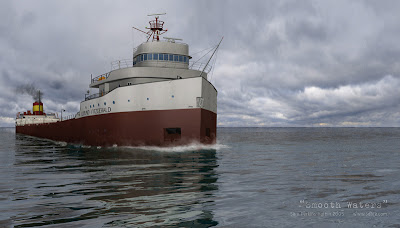
It's been 32 years today? Nothing below is original from me:
The SS Edmund Fitzgerald sank in Lake Superior 20 years ago. Gordon Lightfoot's song "The Wreck of the Edmund Fitzgerald" (1976, Moose Music, Ltd.) is a tribute to this ship wreck and the men who lost their lives. Some of the lyrics of the song are given below along with descriptions of related events.
"..The lake it is said never gives up her dead
when the skies of November turn gloomy
With a load of iron ore 26,000 tons more
than the Edmund Fitzgerald weighed empty...."
On November 10, 1975 the SS Edmund Fitzgerald sank in Lake Superior. All 29 crew members died. At the time, it was the worst shipping disaster on the Great Lakes in 11 years. Other shipping disasters on the Great Lakes, in which weather played a role include:
- Nov. 11, 1913: eighteen ships were lost killing 254 people.
- Nov. 11-13, 1940: 57 men died when three freighters sank in Lake Michigan.
- Nov. 18 1958: 33 men died on Lake Michigan with the sinking of the Carl D. Bradley.
- Nov. 29, 1966: Daniel J. Morrell sank in Lake Huron killing the 28 crew members.
"The ship was the pride of the American side
comin' back from some mill in Wisconsin
As the big freighters go it was bigger than most..."
The Fitzgerald weighted 13,632 tons and was 729 feet long. In 1958, when it was first launched, it was the largest carrier on the Great Lakes, and remained so until 1971. The Fitzgerald was labeled "The Pride of the American Flag". In 1964 it became the first ship on the Great Lakes to carry more than a million tons of ore through the Soo Locks. On November 9, 1975 she departed from Superior, WI with approximately 26,000 tons of ore bound for Detroit MI. Shortly after leaving, the Fitzgerald made contact with the Arthur M. Anderson bound, on a similar route, for Gary IN.
On November 8 a storm was brewing in the plains and proceeded northward towards the Great Lakes. It appeared to be a "typical November storm".
"...and late that night when the ship' bell rang
could it be the north wind they'd bin feelin'."
On November 9 at 7 p.m. the National Weather Service (NWS) issued a gale warning for Lake Superior. In a gale, the wind speeds range from 34-40 knots. The NWS predicted east to northeasterly winds during the night, shifting to NW to N by the afternoon of November 10. At approximately 10:40 p.m. the NWS revised its forecast for eastern Lake Superior to easterly winds becoming southeasterly the morning of the 10th. At about 2:00 am November 10 the NWS upgraded the gale warning to a storm warning (winds 48-55 knots) with a prediction of "northeast winds 35 to 50 knots becoming northwesterly 28 to 38 knots on Monday, waves 8 to 15 feet". Around 2 a.m. the Captains of the Anderson and Fitzgerald discussed the threatening weather and decided to change their route. This safer route would take them northward, toward the coast of Canada. The northern route would protect them from the waves that the storm generated.
The fetch: This is the distance of open water over which the wind blows. The larger the fetch the larger the waves.
At 3 am the winds were reported as coming from the northeast at 42 knots. The Fitzgerald and Anderson proceeded together, the Fitzgerald ahead of the Anderson. They had radio contact and the Anderson's radar located the position of the Fitzgerald.
At 7 am. the storm passed over Marquette MI and started across Lake Superior.
"The wind in the wires made a tattle tale sound
and a wave broke over the railing...."
On the afternoon of November 10 a wind shift was evident. At 2:45 p.m. the winds had backed to NW and were 42 knots. Steady winds at 43 knots and waves of up to 12 and 16 feet were reported by the Anderson. At around this time the Fitzgerald contacted the Anderson and reported "a fence rail down, two vents lost or damaged and a list". A list is when a ship leans to one side. Also around this time, the storm's fury had closed the Sault Ste. Marie locks.
A shift of winds to the NW is very important, as this increased the fetch, allowing large waves to build. The Fitzgerald and Anderson were no longer protected by land.
Late on the afternoon of the 10th, the captain of the Fitzgerald made radio contact with another ship, the Avafor, and reported that they "had a bad list, had lost both radars, and was taking heavy seas over the deck in one of the worst seas he had ever been in." Captain McSorely was a seasoned sailor of the Great Lakes with 44 years of experience.
"...At seven p.m. a main hatchway caved in
he said 'fellas it's bin good to know ya'
The captain wired in he had water comin' in
and the good ship and crew was in peril
and later that night when 'is lights went out of sight
came the wreck of the Edmund Fitzgerald"
At 7 p.m. the Anderson made radio contact with the Fitzgerald and had her on their radar. When asked how the Fitzgerald was making out they replied "We are holding our own". This was around 7:10 p.m.. Shortly afterwards the Fitzgerald disappeared from the Anderson's radar screen.
This phrase of the song, while romantic, makes it sound as if the crew knew they were doomed. In reality the sinking of the Fitzgerald was very rapid and it is likely they did not know the seriousness of their condition. Indeed, after the wreck a severely damaged life boat was found, and only part of the second. The conditions of these lifeboats suggests that no attempts were made to leave the ship. No distress signals were ever issued.
"...They might have split up or they might have capsized
they may have broke deep and took water...."
What caused the ship to sink? There are a couple of theories cited in the "Marine Casualty Report" by the US. Coast Guard Marine Board of Investigation Report. Since there were no survivors nor witnesses, their report is based on testimonies and an underwater survey of the wreck. This report suggests that the Fitzgerald was taking on water due to earlier damage from the storm and that around 7:15 p.m. it plunged headfirst into a large wave and sank abruptly.
Factors contributing to the sinking:
Raising the wintertime load line.
When a ship is filled with cargo, there is a level at which the ship rests in the water. This level is referred to as the load line. The height load line is set as a function of season and determines the weight of the cargo the ship can transport. Between the time of her launch and its sinking, the SS Edmund Fitzgerald load line was raised 3 feet 3 1/4 inches, making her sit lower in the water. This increased the frequency and quantity of water that could flood the deck during a rough storm.
Leaking Hatchways
The ore was loaded through hatchways located top side. On October 31 routine damage was noted during an inspection and were scheduled for repair after the 1975 shipping season. The hatch covers were not sealed properly and were therefore not water tight, thus allowing water to enter the cargo areas. Once water entered it could migrate throughout the hold. There was no way to determine if flooding was occurring in the cargo bay until the ore was saturated, much like a sponge. Throughout the storm the ship was probably taking on water in the cargo hold though the hatches. Increased water loading, and the lower load line, made the ship sit lower in the water, allowing more water to board the ship. Eventually the "bow pitched down and dove into a wall of water and the vessel was unable to recover. Within a matter of seconds, the cargo rushed forward, the bow plowed into the bottom of the lake, and the midship's structure disintegrated, allowing the submerged stern section, now emptied of cargo, to roll over and override the other structure, finally coming to rest upside-down atop the disintegrated middle portion of the ship" (Marine Accident Report SS Edmund Fitzgerald Sinking in Lake Superior). This sequence of events would lead to a rapid sinking, with no time to make a distress call or attempt life-saving operations. The conditions of the recovered lifeboats support this in that they appear to have been torn from their storage racks.
"Does anyone know where the love of God goes
when the waves turn the minutes to hours? "
For more information on the SS Edmund Fitzgerald see:
The Wreck of the Edmund Fitzgerald; Lyrics by Gordon Lightfoot, Moose Music Ltd.
Holden, T., 1991: Lake Superior's wicked November storms. Mariners Weather Log, 4-7.
Knox, J. A. and S. A. Ackerman, 1996: Teaching the extratropical cyclone with the Edmund Fitzgerald storm. 5th AMS Symposium on Education.
Ludington (Mich.) Daily News, November 11, 1975.
Marine Casualty Report, SS EDMUND FITZGERALD; Sinking in Lake Superior on 10 November 1975 with Loss of Life. US. Coast Guard Marine Board of Investigation Report and Commandant's Action. Report No. USCG 16732/64216, Department of Transportation, Coast Guard.
Marine Accident Report SS Edmund Fitzgerald Sinking in Lake Superior, November 10, 1975. May 1978 National Transportation Safety Board, Washington DC. Report Number: NTSB-MAR-78-3
Stonehouse, F., The Wreck of the Edmund Fitzgerald. ISBN 0-932212-05-0, Avery Color Studios, Au Train, MI 49806, 1977, 208 pp.
Please refer questions to Dr. Steve Ackerman/stevea@ssec.wisc.edu or John Knox/jknox@meteor.wisc.edu



